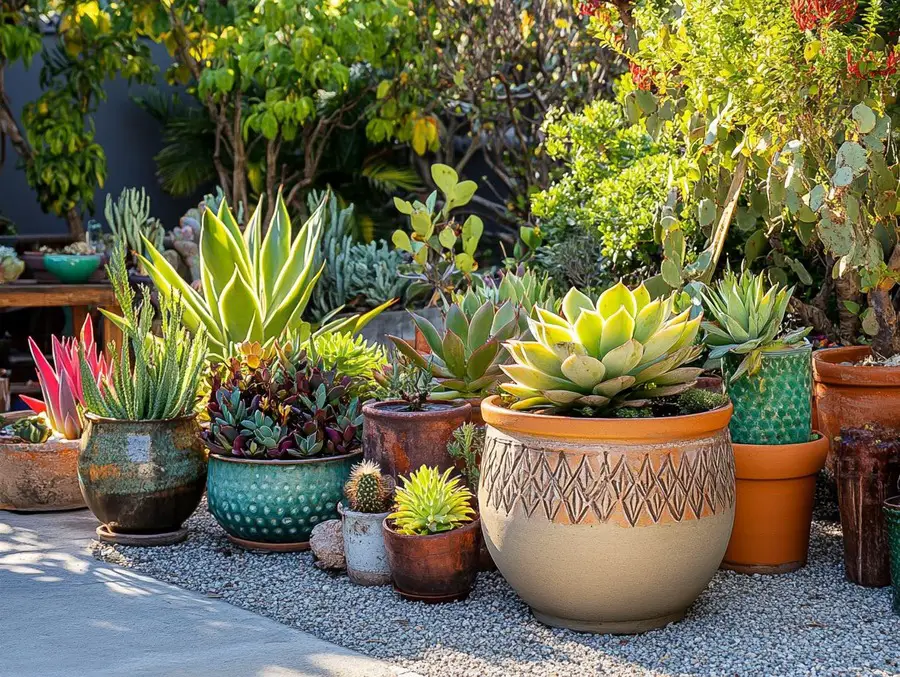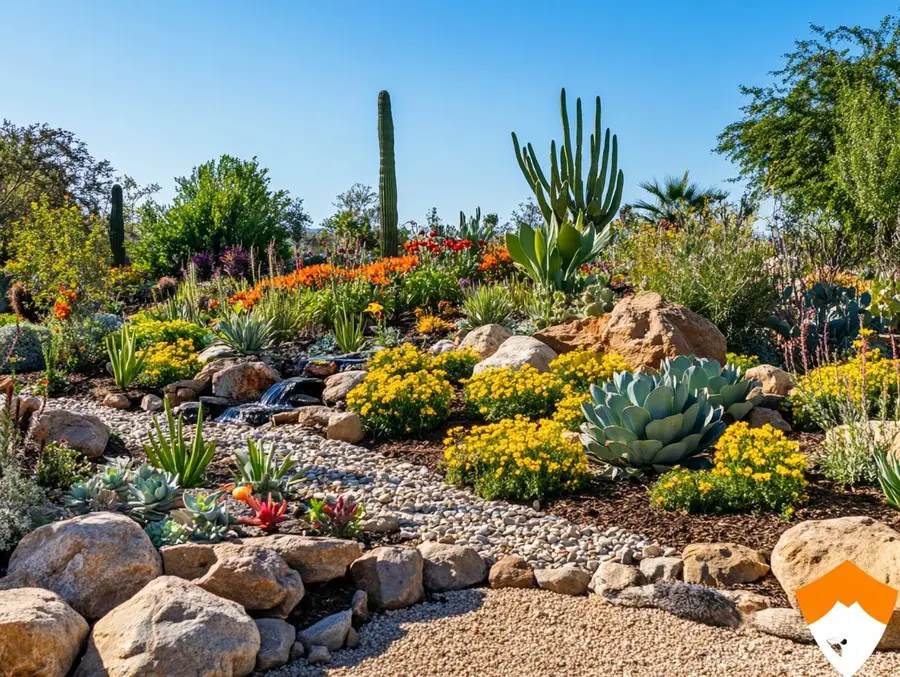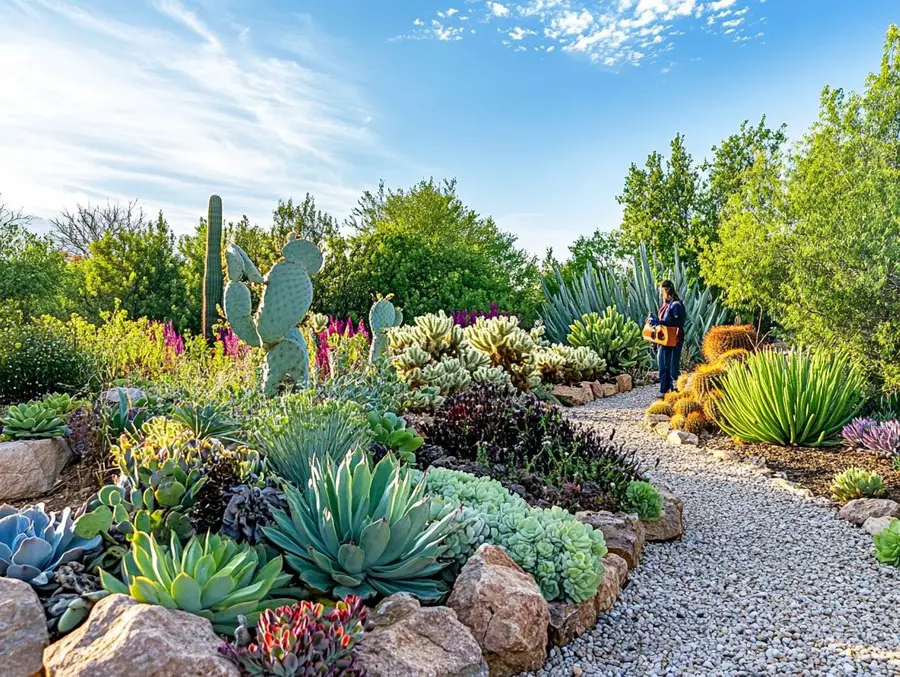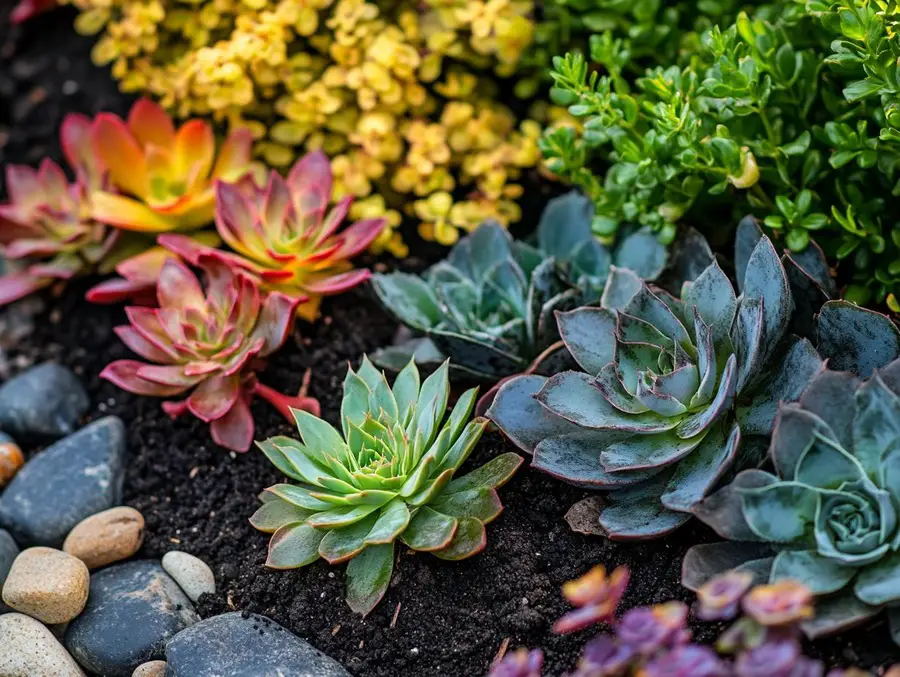We use affiliate links. If you purchase something using one of these links, we may receive compensation or commission.
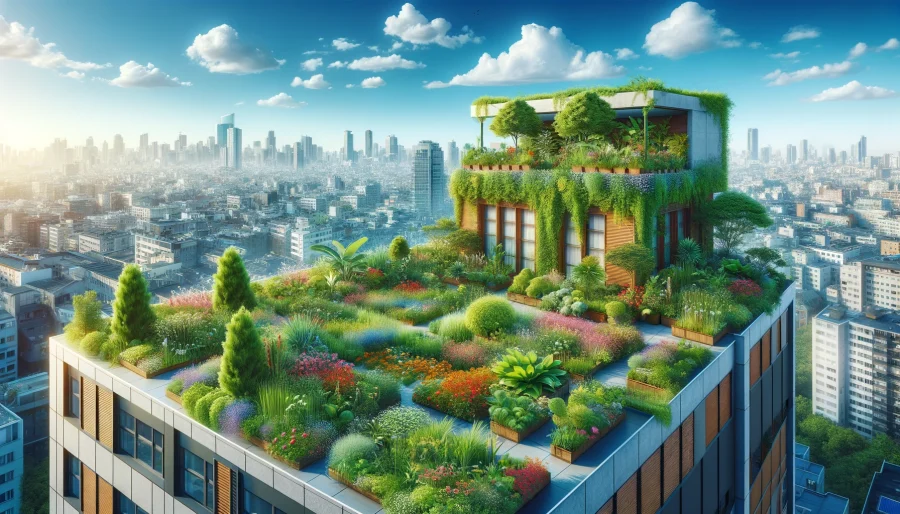
How do rooftop gardens help the environment? They help by playing a role in cooling cities, enhancing air quality, and creating urban oases. Dive into the green revolution!
How Rooftop Gardens Help the Environment Key Takeaways:
- Rooftop gardens help the environment by cooling urban areas, improving air quality, and reducing stormwater runoff.
- They also increase biodiversity by providing habitats for wildlife and reduce energy consumption by insulating buildings.
- These green spaces offer a sustainable solution to urban environmental challenges, making cities more livable and eco-friendly.
Ever wonder how rooftop gardens help the environment? These urban oases are not just a feast for the eyes; they’re a cool breeze for our cities.
By turning rooftops into green spaces, they play a vital role in reducing heat, purifying the air, and inviting nature right into our urban lives.
Let’s dig into the roots of how these gardens are making a difference.
How Do Rooftop Gardens Help the Environment?
Rooftop gardens are a sustainable and innovative way to make a positive impact on the environment.
From reducing the urban heat island effect to improving air quality and increasing biodiversity, these green spaces offer numerous benefits.
In this article, we will explore the various ways rooftop gardens help the environment, the different types of rooftop gardens available, and how you can create your own rooftop garden. Get ready to discover how rooftop gardens are transforming urban landscapes for the better.
What Are Rooftop Gardens?

Rooftop gardens are elevated green spaces created on the roofs of buildings, incorporating vegetation to enhance the urban environment.
These innovative gardens serve various purposes, from providing a tranquil retreat in bustling cities to reducing the urban heat island effect and improving air quality.
The design of rooftop gardens can range from lush green spaces with colorful flowers to functional vegetable gardens that promote sustainability.
Not only do they offer a visual feast for the eyes, but they also support biodiversity by providing habitats for birds, insects, and other wildlife.
A green roof or living roof is a roof of a building that is partially or completely covered with vegetation and a growing medium, planted over a waterproofing membrane. It may also include additional layers such as a root barrier and drainage and irrigation systems.[1] Container gardens on roofs, where plants are maintained in pots, are not generally considered to be true green roofs, although this is debated. Wikipedia
How Do Rooftop Gardens Help The Environment?
Rooftop gardens play a crucial role in environmental conservation by addressing issues such as the urban heat island effect, improving air quality, managing stormwater runoff, enhancing biodiversity, combating climate change, promoting energy efficiency, and fostering sustainability.
One of the significant benefits of rooftop gardens is their impact on mitigating urban heat islands by providing green space that absorbs heat and reduces the overall temperature of buildings and their surroundings.
These gardens help reduce pollution levels by filtering the air of pollutants, such as carbon dioxide and particulate matter, thereby improving the air quality of urban areas.
Reduces Urban Heat Island Effect
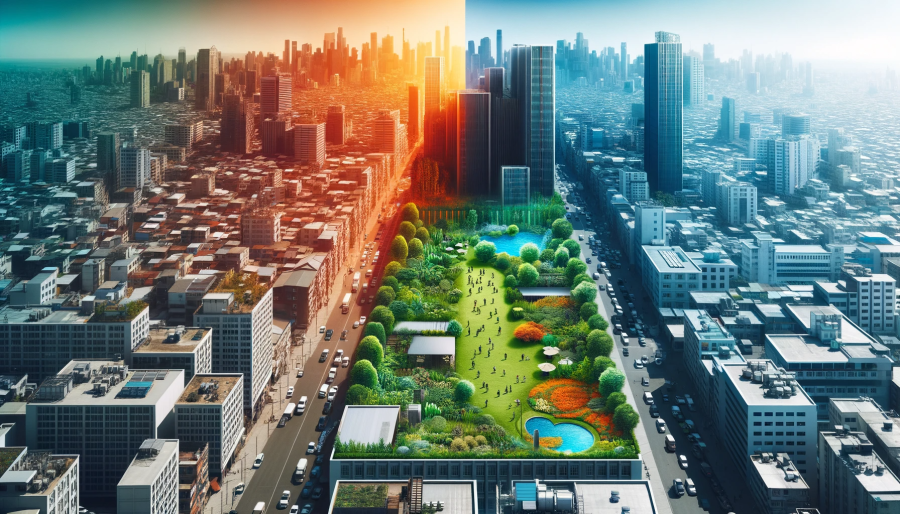
The presence of rooftop gardens aids in reducing the urban heat island effect by lowering ambient temperatures, which leads to diminished building energy use and increased thermal comfort.
Rooftop gardens play a crucial role in mitigating the urban heat island phenomenon through their unique ability to absorb and dissipate heat effectively.
By creating a green barrier, they help reduce the amount of heat absorbed and radiated by traditional rooftops, which are typically dark and heat-absorbing surfaces.
This cooling effect not only decreases the need for air conditioning in buildings, thus reducing energy consumption but also contributes to overall energy savings.
The presence of vegetation on rooftops helps enhance the air quality and biodiversity of urban areas, further improving the city’s ecological footprint.
Improves Air Quality
Rooftop gardens act as natural air purifiers, enhancing air quality by absorbing pollutants, reducing greenhouse gas emissions, and creating a healthier urban environment.
Through the process of photosynthesis, plants in rooftop gardens absorb harmful gases such as carbon dioxide, sulfur dioxide, and nitrogen oxides, that are present in the atmosphere, thereby helping to purify the air.
This absorption of pollutants not only reduces the levels of harmful substances in the air but also plays a role in mitigating climate change by sequestering carbon.
The presence of greenery on rooftops helps to lower the overall ambient temperature in urban areas, thus reducing the need for air conditioning and subsequent energy consumption.
Reduces Stormwater Runoff
Rooftop gardens play a vital role in stormwater management.
By mitigating runoff, promoting natural infiltration, and utilizing native plants to absorb excess water, they reduce the strain on urban drainage systems.
By acting as natural filters, rooftop gardens help to purify rainwater before it flows into storm drains and bodies of water, minimizing the potential for pollution from urban pollutants.
The selection of native plants is critical for their adaptation to the local climate and soil conditions, making them more effective in absorbing water and reducing erosion.
Sustainable water management practices, such as rainwater harvesting and proper irrigation techniques, further enhance the efficiency of rooftop gardens in managing stormwater.
Increases Biodiversity
The presence of rooftop gardens fosters biodiversity by creating habitats for wildlife, supporting native plant species, and increasing ecological richness within urban settings.
Rooftop gardens play a crucial role in providing shelter and food sources for various species of birds, butterflies, bees, and other pollinators, thus promoting a thriving ecosystem in the midst of concrete jungles.
The proliferation of native plants in rooftop gardens helps in restoring and preserving plant biodiversity, contributing to the conservation of endangered plant species and fostering a more sustainable environment.
Mitigates Climate Change
Rooftop gardens play a significant role in mitigating climate change by reducing greenhouse gas emissions, promoting energy savings, and contributing to sustainable practices that help combat the effects of global warming.
By absorbing carbon dioxide and releasing oxygen through the process of photosynthesis, rooftop gardens act as natural carbon sinks, aiding in air purification and reducing the urban heat island effect.
In addition, these green spaces provide insulation, lowering the energy demand for heating and cooling buildings.
Implementing environmentally friendly techniques such as rainwater harvesting and using recycled materials in rooftop garden construction further enhances their impact in creating a more climate-resilient urban environment.
Reduces Energy Consumption
Rooftop gardens enhance energy efficiency by reducing building energy use, lowering cooling demands, and facilitating energy savings through natural insulation and temperature regulation mechanisms.
These green spaces act as a natural buffer against heat, absorbing sunlight and reducing the amount reaching the building’s surface, thus decreasing the need for artificial cooling systems.
This, in turn, leads to a decrease in overall energy consumption, making buildings more sustainable and environmentally friendly.
The insulation provided by rooftop gardens also helps in maintaining stable indoor temperatures, resulting in less reliance on heating during colder months and further contributing to energy conservation.
The cultivation of plants on rooftops can enhance air quality and reduce the urban heat island effect, fostering a healthier and more energy-efficient urban environment.
Provides Green Space in Urban Areas
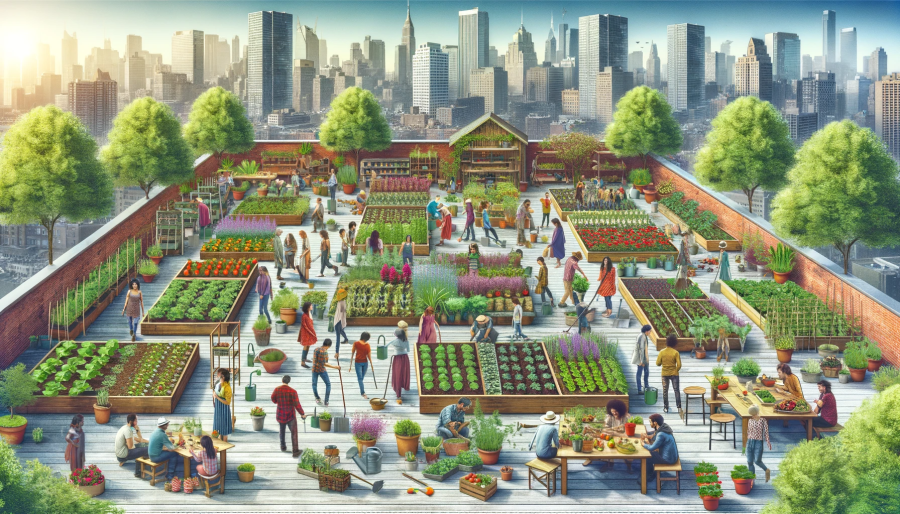
Rooftop gardens offer valuable green spaces within urban environments, providing residents with access to nature, recreational areas, and tranquil retreats amidst bustling cityscapes.
These elevated gardens act as green oases in concrete jungles, contributing to improved air quality by absorbing carbon dioxide and releasing oxygen, therefore aiding in the reduction of pollution levels in densely populated areas.
- Rooftop gardens help insulate buildings, reducing energy consumption for heating and cooling, and mitigating the urban heat island effect, making cities more sustainable and eco-friendly.
- They also play a crucial role in attracting biodiversity, providing habitats for birds, insects, and plants that contribute to the overall ecosystem health of urban areas.
Promotes Sustainable Living

Rooftop gardens promote sustainable living practices by fostering biodiversity, using native plants, and implementing green roof technologies that contribute to environmental protection and resource conservation.
Rooftop gardens play a vital role in promoting sustainable lifestyles by providing habitats for a variety of plants and animals, ultimately enhancing urban biodiversity.
By utilizing native plants, these gardens not only require less maintenance but also support local ecosystems and help conserve water resources.
The adoption of green roof solutions in these urban spaces aids in reducing energy consumption, managing stormwater runoff, and mitigating the urban heat island effect, thus aligning with sustainable development goals.
What Are The Different Types Of Rooftop Gardens?
Different types of rooftop gardens include intensive gardens that require substantial maintenance, extensive gardens with minimal upkeep needs, and semi-intensive gardens that strike a balance between the two approaches.
Intensive rooftop gardens are characterized by their dense planting arrangements, often incorporating a wide variety of plants and structures.
These gardens may require regular watering, fertilizing, pruning, and pest control to maintain their lush appearance.
In contrast, extensive rooftop gardens feature simpler designs with hardier plant species that can thrive with minimal intervention. They are well-suited for low-maintenance green spaces.
Semi-intensive rooftop gardens blend elements of both intensive and extensive designs, offering a middle ground in terms of maintenance requirements and aesthetic appeal.
Intensive Rooftop Gardens
Intensive rooftop gardens are characterized by their high-maintenance nature, diverse vegetation selection, and elaborate design elements that require regular care and management.
These gardens demand meticulous attention to upkeep due to the challenges of maintaining plants in a rooftop setting, such as extreme temperatures and limited soil depth.
The diverse range of plant choices, including succulents, herbs, vegetables, and ornamentals, necessitates tailored care practices for each type.
The intricate design aspects, such as irrigation systems, drainage solutions, and structural considerations, add layers of complexity to their maintenance.
Achieving a flourishing rooftop garden requires a combination of horticultural knowledge, technical expertise, and a commitment to consistent monitoring and care.
Extensive Rooftop Gardens
Extensive rooftop gardens are characterized by their low-maintenance approach, focusing on minimal care requirements, sustainable plant choices, and the creation of additional green spaces in urban settings.
Along with their ease of maintenance, extensive rooftop gardens contribute significantly to urban greenery by transforming underutilized spaces into thriving ecological habitats.
By carefully selecting drought-resistant plants and incorporating efficient irrigation systems, these gardens not only reduce water consumption but also provide habitat for pollinators and wildlife.
Semi-intensive Rooftop Gardens
Semi-intensive rooftop gardens offer a balanced approach between intensive and extensive designs, combining moderate maintenance requirements with a diverse selection of vegetation to achieve an optimal green space solution.
In semi-intensive rooftop gardens, the maintenance needs lie within a middle ground, requiring attention and care without the excessive demands of intensive setups.
This type of garden typically features a varied assortment of plants, including a mix of trees, shrubs, perennials, and ground covers, contributing to a visually appealing and ecologically diverse landscape.
The harmonious balance between intensive and extensive garden features in semi-intensive rooftop gardens creates a dynamic environment that supports biodiversity while maintaining a manageable level of upkeep.
This balance allows for the creation of lush green spaces without overwhelming maintenance demands, making these gardens an attractive option for urban areas seeking sustainable landscaping solutions.
Semi-Intensive Rooftop Gardens: A Closer Look at Rooftop Container Gardening
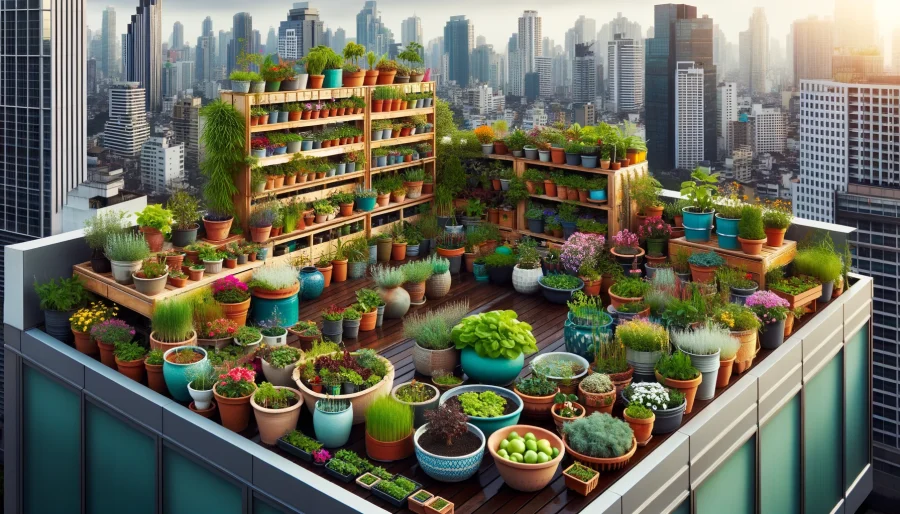
Semi-intensive rooftop gardens offer a unique blend of beauty and functionality, creating verdant spaces in urban environments.
Within this category, rooftop container gardening emerges as a versatile and adaptable option, especially for buildings with limited load-bearing capabilities.
This section delves into the benefits of rooftop container gardening and its role in semi-intensive rooftop garden setups.
Rooftop Container Gardening: Lightweight and Versatile
Rooftop container gardening involves the use of containers or pots to grow plants on rooftops.
This method is lighter in weight compared to traditional extensive or intensive rooftop gardens, making it an ideal alternative for roofs with restricted weight capacities.
Here’s why rooftop container gardening stands out:
Adaptability to Various Roof Types:
Container gardens are highly adaptable, fitting well on different types of roofs regardless of their shape or size.
They can be customized to suit the specific conditions of a rooftop, including sun exposure and wind patterns.
Reduced Structural Load:
One of the significant advantages of container gardening is the reduced weight load on the roof.
Containers allow for the strategic placement of plants, distributing weight more evenly and minimizing the risk of structural strain.
Ease of Installation and Maintenance:
Installing a container garden is straightforward, requiring no extensive modifications to the existing roof structure.
Maintenance is also simpler, as each container can be individually managed, allowing for easy access and care.
Flexibility in Plant Selection:
Container gardening offers the flexibility to grow a wide range of plants, from flowers and shrubs to vegetables and herbs.
This diversity can enhance the aesthetic and ecological value of a rooftop garden, contributing to urban biodiversity.
Optimal Use of Space:
For buildings with limited rooftop space, container gardens provide an efficient solution.
Containers can be arranged in various configurations, maximizing green space without overloading the roof.
Enhancing Semi-Intensive Rooftop Gardens:
Incorporating container gardening into semi-intensive rooftop gardens combines the benefits of both garden types.
It allows for a diverse selection of plants and design elements without compromising the roof’s structural integrity.
This approach supports sustainable urban living by creating accessible, low-maintenance green spaces that contribute positively to the environment.
Portability
Container gardens can be moved to take advantage of varying rooftop conditions.
They are great for renters because they can take them with them if they move.
Rooftop Container Garden Conclusion:
Rooftop container gardening is a practical and sustainable option for enhancing semi-intensive rooftop gardens, particularly on buildings with load-bearing limitations.
By adopting this method, urban dwellers can enjoy the benefits of green spaces while ensuring the safety and longevity of their buildings.
Container gardens represent a step towards more adaptable and resilient urban ecosystems, where green spaces thrive in harmony with the built environment.
How Can Someone Create A Rooftop Garden?

Creating a rooftop garden involves:
- Assessing the weight capacity of the roof
- Selecting the appropriate garden type based on maintenance preferences,
- Preparing the roof surface,
- Choosing suitable plants,
- Establishing a maintenance plan to ensure the garden thrives over time.
When evaluating the weight capacity of your roof, consult a structural engineer to determine if it can support the additional load.
Consider factors like whether the roof is flat or sloped and its exposure to sunlight.
Next, decide on the type of garden you want, such as a container garden, green roof, or hydroponic system, based on your available space and desired level of maintenance.
Then, prepare the roof surface by checking for leaks, ensuring proper drainage, and applying a waterproofing layer if necessary.
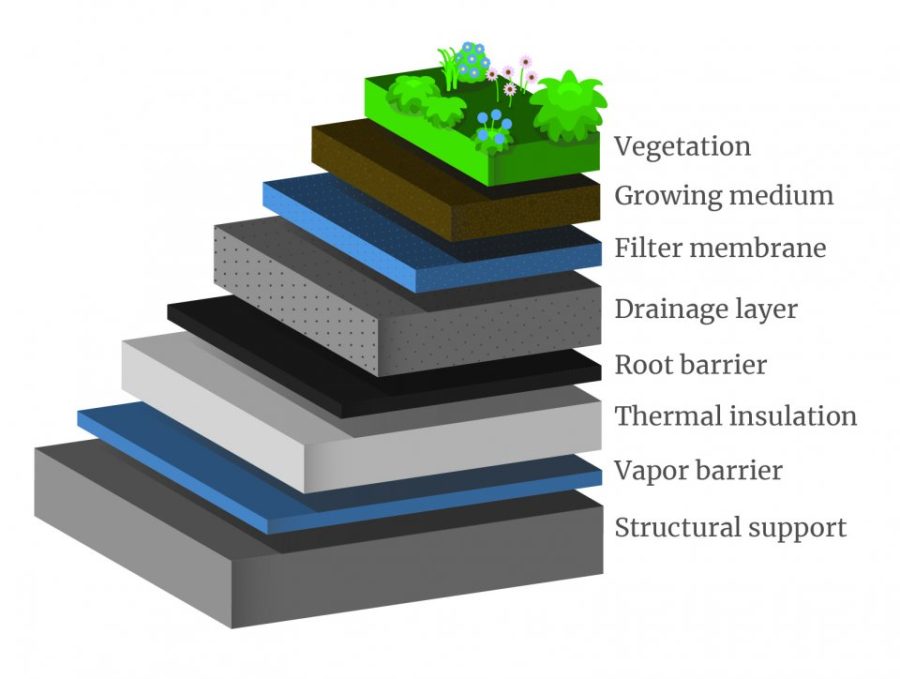
Research plant species that are well-suited for rooftop environments, considering factors like sun exposure, wind tolerance, and soil depth requirements.
Create a detailed maintenance plan that includes watering schedules, fertilization routines, pest control strategies, and regular inspections to address any issues promptly and keep your rooftop garden flourishing.
Determine the Weight Capacity of the Roof
Before creating a rooftop garden, it is essential to assess the weight capacity of the roof through a thorough structural evaluation to ensure it can support the added load of the garden and its components.
Structural assessments play a crucial role in determining whether the roof can withstand the weight of the garden, planters, and any additional features.
Engineers typically evaluate factors such as the roof’s materials, design, age, and current condition to calculate its load-bearing capacity.
By conducting these assessments, potential risks of structural failure can be minimized, ensuring the safety and longevity of the rooftop garden.
It is imperative to adhere to local building codes and regulations to guarantee compliance and enhance the structural integrity of the rooftop space.
Choose the Type of Garden
Selecting the appropriate type of rooftop garden involves considering maintenance preferences, desired garden design elements, and the available time commitment for caring for the garden to ensure it aligns with personal preferences and lifestyle.
One key factor to keep in mind is the maintenance needs of the garden.
Some rooftop gardens require more frequent care and attention, such as watering, pruning, and fertilizing, while others may be more low-maintenance.
In terms of design considerations, think about the aesthetic you want to achieve.
Are you looking for a lush green oasis, a contemporary urban garden, or a mix of flowers and vegetables?
Assess your personal time availability. A rooftop garden that demands extensive time for upkeep might not be suitable if you have a busy schedule.
Prepare the Roof
Preparing the roof for a garden involves implementing waterproofing measures, ensuring proper drainage systems are in place, and addressing any structural concerns to create a suitable environment for plant growth and garden sustainability.
One crucial aspect of preparing a roof for a garden is to start by thoroughly inspecting the surface for any existing leaks or vulnerabilities.
It is essential to repair any damages or weak spots before proceeding with the installation.
Next, applying a high-quality waterproofing membrane plays a key role in protecting the roof from water infiltration, preventing potential water damage to the building structure beneath.
Establishing a reliable drainage system, such as downspouts and gutters, is vital for redirecting excess water away from the garden area to prevent waterlogging.
Conducting structural integrity checks ensures that the roof can support the weight of the garden components without any safety risks.
Select Appropriate Plants
Choosing the right plants for a rooftop garden involves selecting native species that are well-suited to the local climate, ensuring plant compatibility, and considering factors like sunlight exposure and water requirements for optimal growth.
Native plants, known for their resilience and adaptability, are crucial for rooftop gardens as they have evolved to thrive in the specific environmental conditions of the region.
These plants can withstand fluctuations in temperature, sunlight intensity, and precipitation levels typical of rooftop settings.
By choosing native species, gardeners can help support local biodiversity and create a sustainable habitat for birds and insects.
Considering the plant’s compatibility with rooftop conditions such as drainage, wind exposure, and soil depth is essential to ensure their long-term health and vitality.
Maintain the Garden
Maintaining a rooftop garden involves establishing a regular care routine, performing seasonal adjustments, monitoring plant health, and addressing any issues promptly to ensure the garden remains vibrant and sustainable over time.
Consistent care practices play a crucial role in the maintenance of a rooftop garden.
This includes watering the plants regularly, ensuring proper drainage, fertilizing as needed, and controlling weeds.
Seasonal adjustments such as pruning, mulching, and protecting plants from extreme temperatures are essential for the well-being of the garden.
Proactive monitoring involves inspecting plants for pests, diseases, and nutrient deficiencies, and taking timely action to prevent any potential damage.
Regularly checking the soil moisture levels, sunlight exposure, and overall plant growth helps in identifying any underlying issues early on.
Frequently Asked Questions
How do rooftop gardens help the environment?
Rooftop gardens offer a variety of environmental benefits that contribute to a more sustainable and eco-friendly world. Here are some ways they help the environment:
What are the environmental benefits of rooftop gardens?
Rooftop gardens help reduce the urban heat island effect, improve air quality, absorb rainwater, and create habitats for pollinators and other wildlife. The benefits of green roofs have a positive impact on the environment.
Can rooftop gardens help mitigate the effects of climate change?
Yes, rooftop gardens can help mitigate the effects of climate change. They absorb carbon dioxide, a greenhouse gas, and release oxygen into the atmosphere. They also reduce energy consumption in buildings, thus reducing carbon emissions.
How do rooftop gardens help with stormwater management?
Rooftop gardens absorb rainwater, which helps prevent flooding and runoff. This reduces the strain on drainage systems and helps improve water quality by filtering out pollutants.
Do rooftop gardens have any economic benefits?
Aside from their environmental benefits, rooftop gardens also have economic benefits. They can reduce energy costs by providing natural insulation, increase property value, and potentially save money on stormwater fees.
Can anyone create a rooftop garden?
Yes, anyone can create a rooftop garden. It can be as simple as a few potted plants or a more elaborate setup with a variety of plants. However, it is important to consult a professional for structural safety and proper garden design to ensure the success and safety of your rooftop garden.
Conclusion
Wrapping up here’s how rooftop gardens help the environment:
They reduce urban heat, improve air quality, manage stormwater, and boost biodiversity.
By insulating buildings, they also cut energy use, showcasing a sustainable approach to urban design and making cities more livable and environmentally friendly.
Transforming Urban Landscapes:
Rooftop gardens are changing the face of urban areas, turning barren rooftops into vibrant green spaces.
These gardens are more than just beautiful; they’re a powerful tool in the fight against climate change and urban heat islands.
By absorbing carbon dioxide, filtering pollutants from the air, and providing natural insulation, rooftop gardens are at the forefront of sustainable urban development.
A Breath of Fresh Air:
In cities where concrete often outweighs greenery, rooftop gardens offer a breath of fresh air.
They prove that urban spaces can also be green spaces, providing residents with much-needed access to nature and promoting well-being.
As these gardens flourish, they not only improve the environment but also enhance the quality of life for city dwellers.
The Future of Green Roofs and Urban Greening:
Looking ahead, the potential for rooftop gardens in urban greening is immense.
By embracing these spaces, cities can tackle environmental issues head-on, creating healthier, more sustainable environments for future generations.
The movement towards rooftop gardening is a step towards a greener, more resilient urban future.
Related Content
Visit my Amazon Influencer Page for videos and gardening products Grow Your Own Garden

